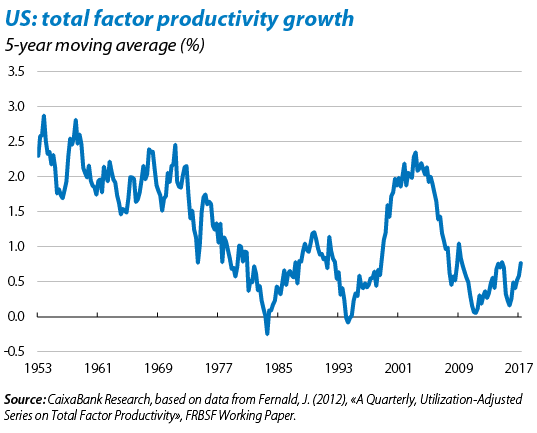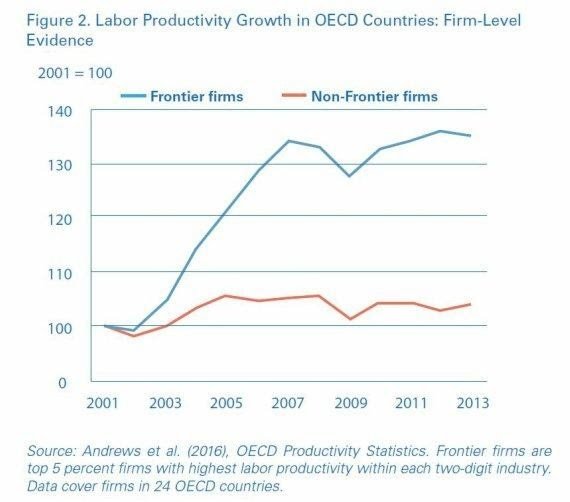Did you know that growth in productivity is getting slower and slower? Yes, it seems like a contradiction in the middle of the era of artificial intelligence, the cloud, self-driving cars and Zoom meetings! The topic would not be so important if it were not for the fact that productivity is a broadly used indicator. In a world fearful that computers and robots will end up with many people's jobs, it seems absurd!
In fact, this is not a new topic. It was popularized in 1987 by the Nobel Prize-winning economist Robert Solow: "You can see the computer age everywhere but in the productivity statistics". A few years have gone by since 1987, but what has been called the Solow Paradox is still there. So much so that last year two CaixaBank economists, Oriol Carreras and Adrià Morron, published a study on precisely this subject from which we have extracted the following graph:

Surprised? No doubt you ask yourself: why do we have decreasing productivity growth? In fact, it’s the result of how it is measured. Productivity is the value in monetary units - the price of things - divided by the total costs necessary to produce them. Thus, you can see what’s going on. If a TV set in 1956 cost 30,000 pesetas - €7,000 would be the current equivalent price - and we see that today an average television costs around €300 and as well wages have gone up, then we must conclude that productivity growth is not zero, it is negative!
The digital revolution has worsened the growth of productivity
Not only that, the digital revolution has greatly worsened this problem. Today we all carry a smartphone, which is expensive, no doubt, but it is the equivalent of a camera + a phone + a notepad + an agenda + a clock + an alarm clock + a radio + a music device + an encyclopedia + ... of course if we add it all up and adjust to today's prices, the smartphone, despite being expensive, is much cheaper than all this combined!
Added to this is the fact that many of the services that we consume are free, such as Google Maps, many newspapers, much of the music, dictionaries, encyclopedias, etc. All of this existed and was part of productivity, but now we don't pay for any of that, not anymore.
There are other factors too, for example, tax engineering, which situates as much value as possible in tax havens in order to avoid taxes, thus distorting the calculation of productivity. Further cases: what happens when the quality of a product rises greatly but its price doesn’t, and the case of unpaid work. None of these things count for productivity. It is obvious that we have a problem in how we calculate it. It’s a topic where there is a lot of debate, but few agreements.
But all this contrasts greatly with what we have right in front of us: the evidence of Google, Apple, Facebook, cloud companies such as Amazon Web Services (AWS), and so on, all with very few workers (for example, 44,940 at Facebook; 12,700 in AirBnB; and 25,000 at AWS) and who make a lot of money in digital businesses. It is quite clear that the productivity of these companies is enormous, something that you could not have even dreamed of 50 years ago!
The statistics hide the difference between the best companies and the average ones
This is the secret power that the statistics hide. The huge difference between the productivity of the best companies and that of average companies.

The big question, then, is: what can we ourselves do to be among the best? Among those whose productivity is radically improved by their technology. Let me tell you a personal experience, one that will probably sound familiar to you.
Many years ago, I was CTO of a boutique bank and part of our job was the Digital Transformation of the bank's processes. To take an example, the process of granting credits and loans. It is a process that started with a client asking for a loan, a credit or a mortgage. A file was opened where all the papers were collected together with the bank's own information. From there, this folder went to the branch credit committee that attached its decision, reflected in the branch report. If all this was favourable, it went to the bank's credit commission (it was a small bank and we didn’t have a regional one) where another report was created and finally, either the operation was approved, or more information was requested, or it was denied. All of this implied a huge amount of paper being carried around, went up and down the corridors in large carts full of reports from all offices, it was a really curious spectacle!
About twenty years ago the digital transformation of this process consisted of entering the branch reports and those of the credit committee into the computer and automatically producing many of the documents and an initial credit scoring. The papers, and the cart to carry them, were still there. This, however, is not really the most significant aspect.
Let's look at it from a productivity point of view. Did we gain any productivity? In fact, the number of operations that the system processes is the same afterwards as it was before, because there was no saturation and the time saved by printing consolidated statements instead of printing them one by one was not major. Neither did the gains from introducing credit scoring - perhaps this improved the quality and the ratios a bit, but not the productivity. And finally, the decisions were made by groups of executives for whom the aggregated data, although making their work easier, did not constitute any radical change in productivity or in the average time of studying an operation. Of course, although it was done with internal resources, the design, development and roll-out of this operation required quite some resources. If we add it all up, we are probably talking about negative productivity!
This is not a strange situation, but on the contrary, quite common. What has happened? What are we doing wrong? If you look closely, the number of stages in the process is the same, the real bottleneck is the meeting of the credit committee and there is no kind of saturation in this, and therefore, no improvement in productivity..
To increase productivity, what we have to do is rethink the entire process, transform it.
If we wanted to increase productivity, what we would have to do is rethink the entire process, transform it. Are there no credits that can be automatically granted? Is there no additional information that can be requested automatically? Are there no operations that can be automatically denied? An affirmative answer to any of these questions would improve productivity and reduce the stack of papers that went up and down. If we were to make papers disappear completely and we could move even more decisions to software making them automatic, even instantaneous, then we would also improve the time needed to approve operations.
It is not about using computers, AI or the cloud to do the same thing we did before but with computers, AI or the cloud. It is about doing it differently or doing things that we would never have dreamed of doing before.
It is about injecting as much change as possible. How? Start by copying, and making even better, not those people who do things just a little better than you, but those who do them a whole lot better than you!
Esteve Almirall
Associate Professor at ESADE, Department of Operations, Innovation and Data Science. Director of the ESADE Centre for Innovation in Cities.
